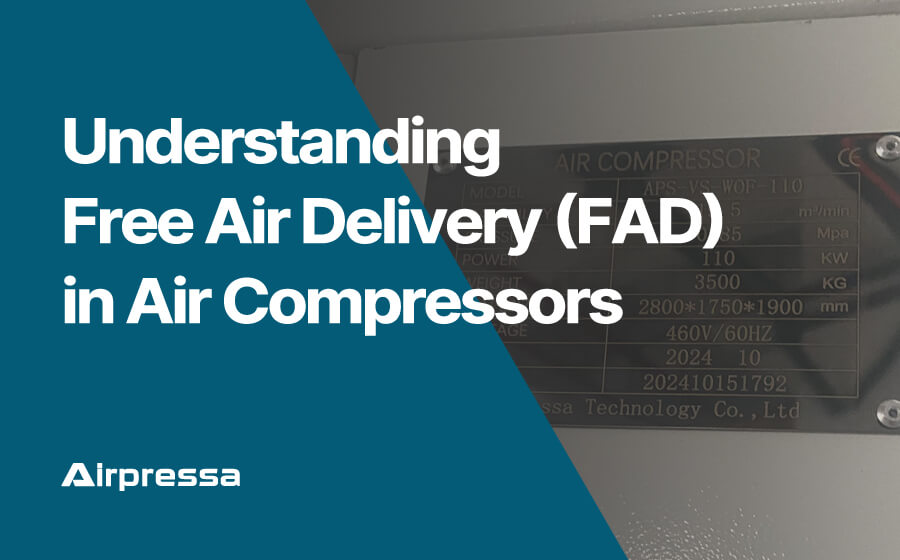
You can click on any section that you interest to get there quickly.
What it the Free Air Delivery (FAD)?
Free Air Delivery (FAD) is a critical parameter in the field of air compressors, representing the volume of air that a compressor can deliver at a specified pressure and temperature, typically under standard atmospheric conditions.
This metric provides a clear indication of the compressor’s ability to produce compressed air under various operating conditions.
In simple terms, FAD measures the amount of air that a compressor can draw in from the atmosphere, compress, and then deliver at a specified outlet pressure. It is typically expressed in cubic meters per minute (m³/min) or cubic feet per minute (cfm).
The standard conditions for FAD measurement are usually defined as 1 bar (14.5 psi) pressure and 20°C (68°F) temperature, with 0% relative humidity.
The Significance of FAD in Air Compressors
FAD is a crucial factor in determining the overall performance and efficiency of air compressors. It directly impacts several aspects of compressor operation, including power consumption, capacity, and the quality of compressed air produced.
Power Consumption and Efficiency
A higher FAD value indicates that the compressor can deliver more air at a given pressure, which generally means it is more efficient in terms of power consumption. This is because a more efficient compressor can produce the same amount of compressed air using less energy, leading to lower operational costs.
Air Capacity and Production
FAD also means the capacity of an air compressor, which is the amount of compressed air it can produce within a specific time frame. A higher FAD value means that the compressor has a greater capacity, allowing it to meet the demands of more demanding applications.
What Types of Air compressor? The Complete List
There are many types of air compressor, positive and dynamic air compressors are two main types, each with its own advantages and applications.
Positive air compressors rely on positive displacement to deliver a continuous flow of compressed air, while dynamic air compressors use high-speed impellers to achieve compression.
Understanding the differences between these compressor types can help industries choose the most suitable comp1ressor for their specific needs.
Factors Influencing Free Air Delivery
Several factors can influence the FAD value of an air compressor, including the type of compressor, its operating conditions, and the ambient temperature and pressure.
Type of Compressor
Different types of air compressors, such as reciprocating, rotary screw, and centrifugal compressors, have different FAD values due to their distinct designs and operating principles. For example, rotary screw compressors generally have higher FAD values than reciprocating compressors, making them more suitable for applications requiring high airflow rates.
Operating Conditions
The operating conditions of an air compressor, such as inlet temperature, pressure, and humidity, can significantly affect its FAD value. For instance, a higher inlet temperature can reduce the FAD value by increasing the air’s density and making it more difficult for the compressor to compress the air.
Ambient Temperature and Pressure
The ambient temperature and pressure at which the compressor operates can also impact its FAD value. Compressors operating at higher altitudes or in warmer environments may have lower FAD values due to the reduced air density and increased difficulty of compressing the air.
Measuring and Calculating Free Air Delivery
Accurately measuring and calculating FAD is essential for ensuring the efficient operation of air compressors and maintaining the desired air quality. The following methods are commonly used to measure FAD:
Direct Measurement
Direct measurement involves using flow meters and pressure gauges to measure the volume of air delivered by the compressor at the specified outlet pressure and temperature. This method provides the most accurate FAD value but requires specialized equipment and expertise.
Indirect Calculation
Indirect calculation involves using the compressor’s specifications and operating conditions to estimate its FAD value. This method is less accurate than direct measurement but can be useful when specialized equipment is not available.
Importance of Accurate Measurement Free Air Delivery
Accurate measurement of FAD is crucial for optimizing the performance of air compressors and ensuring the production of high-quality compressed air. By accurately measuring FAD, operators can identify potential issues with compressor performance and take corrective action to improve efficiency and reduce operational costs.
Free Air Delivery: Convert cfm to m3/h
The chart of convert cfm to cubic metre per hour